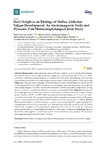Heel Height as an Etiology of Hallux Abductus Valgus Development: An electromagnetic Static and Dynamic First Metatarsophalangeal Joint Study

Use este enlace para citar
http://hdl.handle.net/2183/29964Coleccións
- GI-UDISAP - Artigos [196]
Metadatos
Mostrar o rexistro completo do ítemTítulo
Heel Height as an Etiology of Hallux Abductus Valgus Development: An electromagnetic Static and Dynamic First Metatarsophalangeal Joint StudyAutor(es)
Data
2019Cita bibliográfica
Sánchez-Gómez, R.; Becerro de Bengoa-Vallejo, R.; Losa-Iglesias, M.E.; Calvo-Lobo, C.; Romero-Morales, C.; Martínez-Jiménez, E.M.; Palomo-López, P.; López-López, D. Heel Height as an Etiology of Hallux Abductus Valgus Development: An electromagnetic Static and Dynamic First Metatarsophalangeal Joint Study. Sensors 2019, 19, 1328. https://doi.org/10.3390/s19061328
Resumo
[Abstract] Background: Hallux abductus valgus (HAV) is a forefoot condition produced by extrinsic and intrinsic factors. Shoes with a high heel height and a typical narrow tip toe box can induce deviations in both the proximal phalanx of the hallux (PPH) and the first metatarsal (IMTT) bones. Nevertheless, the isolated role of heel height remains unclear in the development of HAV pathology. Objectives: The goal was to determine if the heel height increase of shoes without a narrow box toe could augment the PPH and IMTT deviation in frontal, sagittal, and transverse planes toward the first metatarsophalangeal joint (MPJ) and the first metatarsocuneiform joint (MCJ), respectively, during static and dynamic conditions in relation to precursor movements of HAV. Methods: Women with an average age of 25.10 ± 4.67 years were recruited in this cross-sectional study to assess the three planes of motion of PPH and IMTT while wearing high heels with heights at 3, 6, 9 cm and unshod conditions via sandals. The measurements used an electromagnetic goniometer device with sensors placed on medial aspects of the PPH and IMTT bones under static and dynamic conditions. Results: Wearing shoes with a 6 cm heel in dynamic condition may increase the PPH valgus and abduction deviation from 3.15 ± 0.10° to 3.46 ± 0.05° (p < 0.05) and from 1.35 ± 0.28° to 1.69 ± 0.30° (p < 0.001), respectively. In addition, a PPH abduction increase from 1.01 ± 0.36° to 1.31 ± 0.46° (p < 0.05) after wearing shoes with a 6 cm heel height was observed under static conditions. Conclusions: Wearing shoes with a heel height of 6 cm without a narrow box toe interference may produce PPH abduction and valgus deviations related to HAV formation.
Palabras chave
Hallux abductus valgus
Hallux abducto valgus
High heel
Tacones
Proximal phalanx of the hallux
Falange proximal del hallux
Abduction
Abducción
Valgus
Hallux abducto valgus
High heel
Tacones
Proximal phalanx of the hallux
Falange proximal del hallux
Abduction
Abducción
Valgus
Versión do editor
Dereitos
Atribución 3.0 España
Ítems relacionados
Mostrando ítems relacionados por Título, autor ou materia.
-
Prevalencia de las patologías del primer radio en personas que practican boxeo
Rodríguez Cajigal, Paloma (2020)[Resumen] El boxeo es un deporte de combate que consiste en el enfrentamiento entre dos competidores, donde la victoria se consigue aplicando un conjunto de acciones técnico- tácticas determinadas por un reglamento oficial. ... -
Influencia del hallux limitus/rigidus en la marcha
Castro Fernández, Iria (2019)[Resumen] Objetivos: Cuando la primera articulación metatarsofalángica no alcanza durante la marcha 20º de flexión dorsal pero sí existe un rango de movimiento de flexión dorsal pasiva de 65º-75º de la misma en descarga, ... -
Geometry of the Proximal Phalanx of Hallux and First Metatarsal Bone to Predict Hallux Abducto Valgus: A Radiological Study
López-López, Daniel; Becerro-de-Bengoa-Vallejo, Ricardo; Losa Iglesias, Marta Elena; Pérez-Boal, Eduardo; Fuentes Rodríguez, Miguel (PLOS, 2016-11)[Abstract] Background Hallux abducto valgus (HAV) is one of the most common forefoot deformities in adulthood with a variable prevalence but has been reported as high as 48%. The study proposed that HAV development involves ...






